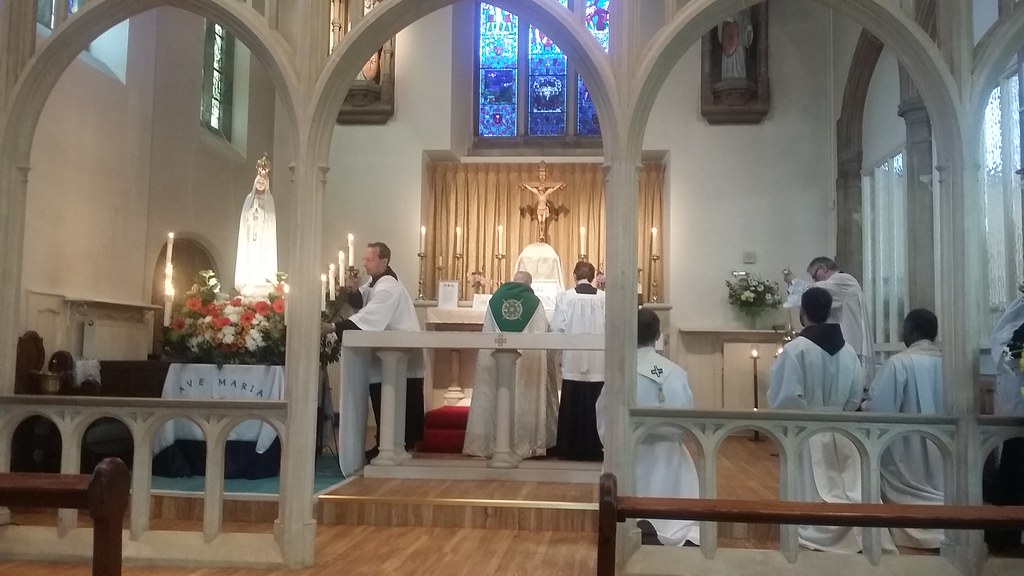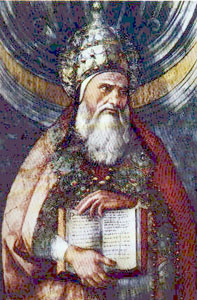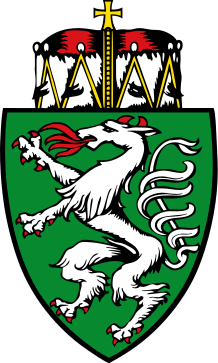, Austria. The oldest remaining Monastery in
, Austria, Admont Abbey contains the largest Monastic Library in the World, as well as a long-established scientific collection. It is known for its
architecture, Art, and Manuscripts.
," "at the mountains") is of unusual scenic beauty.
Dedicated to
Saint Blaise, Admont Abbey was founded in 1074 by Archbishop
Gebhard, of Salzburg, with the legacy of the Late-Saint,
Hemma of Gurk, and settled by Monks from
Saint Peter's Abbey, in Salzburg, Austria, under Abbot Isingrin. The second Abbot, Giselbert, is said to have introduced The
Cluniac Reforms. Another of the early Abbots, Wolfhold, established a Convent for the
education of girls of noble family, and the educational tradition has remained strong ever since. The Monastery prospered during The
Middle Ages and possessed a productive
Scriptorium. Abbot
Engelbert, of Admont, (1297–1327) was a famous scholar and author of many works.
English: Admont Abbey,
Styria, Austria.
Deutsch: Stift Admont, Foto: P. Gabriel Reiterer.
Photo: 21 September 2005.
Source: Photo: P. Gabriel Reiterer.
(Wikimedia Commons)
The Wars against the
Turks, and The
Reformation (Abbot Valentine was obliged to resign because of his Reformed views), caused a lengthy decline, but, with The
Counter-Reformation, the Abbey flourished once again. In addition to the Secondary School, which later moved to
Judenburg, there were faculties of Theology and Philosophy. Abbot Albert von Muchar was well known as an historian and taught at the
University of Graz.
In the 17th- and 18th-Centuries, the Abbey reached a high point of artistic productivity, with the works of the world-famous ecclesiastical embroiderer Brother Benno Haan (1631–1720) and the sculptor Joseph Stammel (1695–1765).
On 27 April 1865, a disastrous fire destroyed almost the entire Monastery. While the Monastic archives burned, the Library could be salvaged. Reconstruction began the following year, but was still not complete by 1890.
English: Coat-of-Arms of Styria, Austria.
Date: Unknown date.
File: 2006-05-27.
Source: Based on Coat-of-Arms of Styria,
depicted on www.verwaltung.steiermark.at
Author: Unknown.
(Wikimedia Commons)
The economic crises of the 1930s forced the Abbey to sell off many of its art treasures, and, during the period of The
National Socialist government, the Monastery was Dissolved and the Monks evicted. They were able to return in 1946 and the Abbey, today, is again a thriving Benedictine Community.
From 1641, the Abbey was a Member of The
Salzburg Congregation, which, in 1930, was merged into the present
Austrian Congregation of The
Benedictine Confederation.
The present Church was designed by the architect Wilhelm Bücher, to replace the former Church after the fire of 1865. It is inspired by
Regensburg Cathedral and was the first Sacred Building in Austria in the
Neo-Gothic Style. It incorporates 12th-Century
Romanesque Side Doors. The two West Towers are sixty-seven metres tall, and the facade contains figures of
Saint Benedict and
Saint Scholastica. The figure of the Church's Patron,
Saint Blaise, tops the Pinnacle of The Great West Door.
English: The Nave of Admont Abbey Church, Admont, Styria, Austria.
Deutsch: Langhaus der Stiftskirche Admont, Admont, Steiermark.
Photo: 18 June 2012.
Source: Own work.
(Wikimedia Commons)
The Interior consists of a Central Aisle and two Side Aisles, off each of which are five Side Chapels and six Altars. The picture on the Altar of Mary,
Maria Immaculata, by
Martino Altomonte (1657–1745), is surrounded by fifteen carved Medallions of The Secrets of The Rosary, by
Joseph Stammel. Both works of art were created in 1726 and survived the fire of 1856.
In a Side Chapel, is located the famous Crib of Admont, also by Stammel. It is open to view from 25 December to 2 February. The
Gothic Crucifix, under The Triumphal Arch, dated 1518, is ascribed to
Andreas Lackner.
A statue of Saint Blaise stands on top of The High Altar of White
Carrara Marble. The
Choir is decorated with Early-18th-Century tapestries, by
Benno Haan. In The Chapel of Saint Benedict, is a Baroque
Corpus Christi, from the workshop of
Johann Meinrad Guggenbichler.

English: The Abbey Church,
Admont Abbey,
Austria.
Deutsch: Stift Admont, Stiftskirche.
Photo: 14 February 2007.
Source: Own work.
(Wikimedia Commons)
The Community at Admont consists of over twenty-seven Monks, under Abbot Bruno Hubl. The Abbey is responsible for: Twenty-seven Parishes; runs a Secondary School with about 600 pupils; and an Old People's Home in Frauenberg, Austria. Its various businesses and enterprises employ about 500 people, and it also has the management of the Museums and Collections, detailed below.
The Library Hall, built in 1776 to designs by the architect
Joseph Hueber, is seventy metres long, fourteen metres wide and thirteen metres high, and is the largest Monastery Library in the World. It contains
circa 70,000 volumes of the Monastery's entire holdings of
circa 200,000 volumes. The Ceiling consists of seven Cupolas, decorated with frescoes by
Bartolomeo Altomonte showing the stages of human knowledge up to the high point of Divine Revelation. Light is provided by forty-eight windows and is reflected by the original colour scheme of Gold and White. The architecture and design express the ideals of The
Enlightenment, against which the sculptures by
Joseph Stammel of "The Four Last Things" make a striking contrast.
The Abbey possesses over 1,400 Manuscripts, the oldest of which, from
Saint Peter's Abbey, in Salzburg, Austria, were the gift of the Founder, Archbishop Gebhard, and accompanied the first Monks to settle here, as well as over 900
Incunabulae.

English: The Nave of Admont Abbey Church, Admont, Styria, Austria.
Deutsch: Langhaus der Stiftskirche Admont, Admont, Steiermark.
Photo: 18 June 2012.
Source: Own work.
(Wikimedia Commons)
Since the Baroque period, the Abbots had accumulated a collection of "curiosities" and scientific specimens of various sorts, which were entirely destroyed in the fire of 1865. As part of the reconstruction,
Father Gabriel Strobl determined to replace the lost collections, and so formed the nucleus of the modern Museums. Father Strobl was a botanist, but also worked on building up the insect collection, so much so that he became one of the great entomologists of his day. The Natural History Museum now contains over 250,000 insect specimens, including one of the three largest collections of
flies, or
Diptera, in Europe. Other collections of, for example, minerals and rock, and exotic species, have also been formed.
The Abbey also houses two major Art Collections of Historical and Modern Art. The Historical Art Collection was begun in 1959 by Father Adalbert Krause, and has been significantly augmented since 1980. The present Museum was opened in 2003. The Collection particularly features Ecclesiastical Art, and contains, for example, many works of Ecclesiastical Embroidery by the famous Craftsman, Benno Haan, and of the Abbey Sculptor, Joseph Stammel.
Since 1997, the Abbey has also been building up a Collection of Contemporary Art, largely produced by young Austrian artists and often specially designed for the Abbey premises.
English: Admont Abbey Church viewed from the Park.
Deutsch: Ansicht der Stiftskirche Admont vom Park, Steiermark.
Photo: 3 May 2014.
Source: Own work.
(Wikimedia Commons)















































